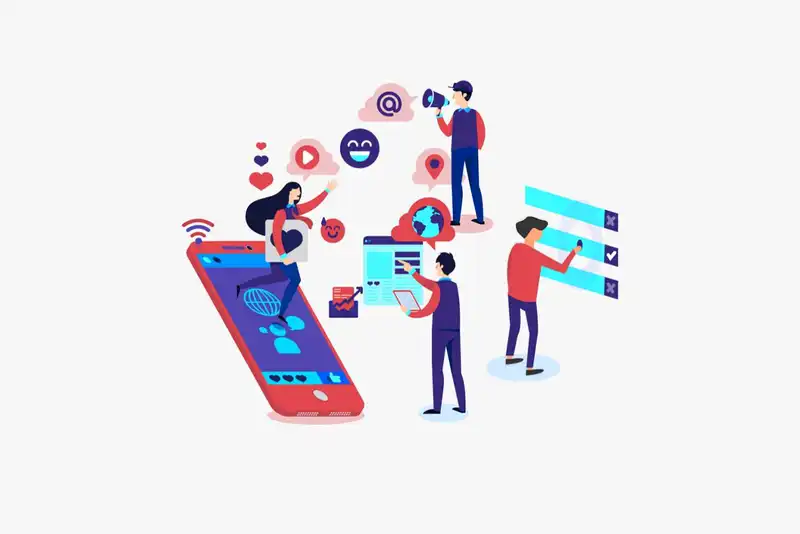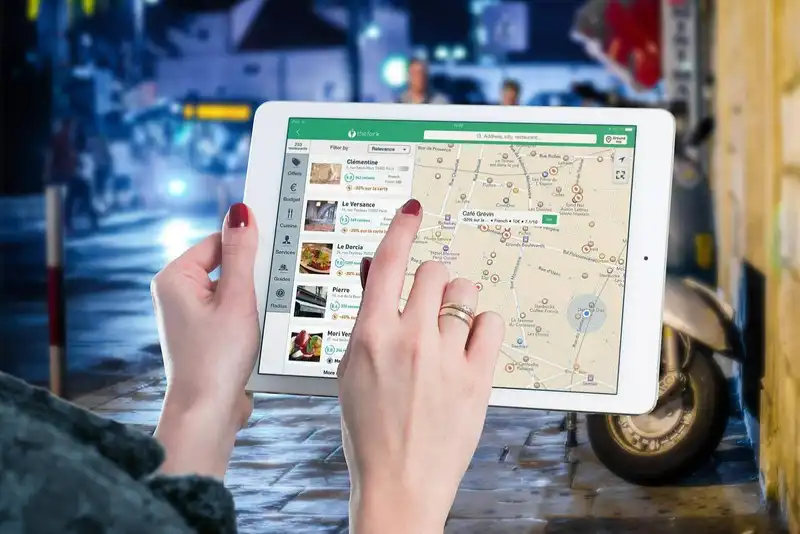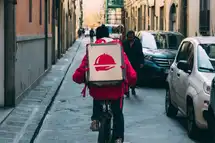What are restaurant marketing ideas and trends?
Some popular restaurant marketing ideas and trends include online ordering, delivery services, social media marketing, and coupons or discounts.
7 Restaurant Marketing Ideas And Trends That Can Turn Your QSR Business Around
The Quick Service Restaurant Business in America

The sandwich shop, The Original Beef of Chicagoland, is in tatters. Mucky floor. Worn out walls. Dysfunctional kitchen equipment. Clogged washroom. Inept, disgruntled employees. Not enough raw material. Lack of inventory management. And, a new manager-owner.
The quick service sandwich deli is the scene of action for the much-talked about FX-Hulu show, The Bear. The chaotic scenes and realistic portrayal of restaurant life make this new show (set in the aftermath of the Covid-19 pandemic) an urgent watch, especially for people from the restaurant industry. There's a lot to learn and more to introspect.
In reality, America's quick service restaurant business was on the upswing for over two decades. But the pandemic got the better of it. Market research firm, The NPD Group, published a telling study in July 2022, which revealed that visits to QSRs -- which constitutes 82% of total restaurant visits -- dwindled by 2% in the second quarter of 2022, compared to the same quarter in 2021. Moreover, the traffic in QSR-fast casual segment has been down too -- in the second quarter of 2022, it was down 1% compared to last year.
Consumers are currently dealing with rapidly rising inflation and escalating prices. According to David Portalatin, NPD Food Industry Advisor and author of 'Eating Patterns in America', "consumers respond to higher menu prices in three ways"- trading down to lower-priced items, cutting back on the number of items ordered, or reducing restaurant visits altogether.
However, what can help restaurant businesses in these tough times is mastering the menu, strengthening operations, and devising interesting marketing plans around new ideas and trends. What would help even more is implementing their marketing strategy in a way that engages customers and brings them back to the restaurant.
Towards the end of the first season of The Bear, the business, which is in debt, makes slow progress towards recovery. An inadvertent newspaper article (praising one of its delicacies) leads to an unexpected flood of customers. The staff and owner are unable to deal with it, and much drama unfolds. But then it's a fictional show, and it won't work without drama.
In reality, of course, it takes more than happenstance and luck to make a restaurant work. What can do the trick, though, is a solid marketing plan. This article takes a look at seven marketing strategies that can help boost a QSR's brand value, bring in new customers, and retain old ones.
1. Social Media Marketing for a World That Lives Online

One needs to be au fait with social media to communicate in the modern world. Social media has changed how we operate, interact, and do our daily chores. It's changed how companies conduct business and engage with their customers, irrespective of their industry.
Having a social media presence isn't an option anymore, it's a necessity, given how digitally savvy customers have become. Restaurants must create a presence online and curate it in such a way that the brand value is identifiable.
The pizza chain Domino's is a leader in social media marketing. The brand that was often referred to as the poor man's Pizza Hut till a decade ago turned around its image with snazzy social media campaigns. In 2015, the brand recognized that emojis had become a language of their own. So, tapping its younger, digitally-savvy target group, it launched a service that enabled customers to tweet in their order with a pizza emoji. A great way to simplify ordering and make it fun at the same time!
By 2016, the brand had realized that younger social media users had started moving on from Twitter and Facebook and were leaning towards Snapchat. It's So Tasty The Mouth Boggles campaign incorporated the Snapchat face-swapping feature that was all the rage at the time. The brand has made small but successful strides and is today a leading pizza chain with over 18,000 stores globally.
With targeted social media marketing strategies, a QSR business can turn its business around in no time. Here's what social media allows a restaurant to do-
- Post menu updates regularly
- Engage with customers
- Share recipes in different ways, as Insta reels or TikTok videos
- Acquaint customers with what's happening behind the scenes, with photos and videos
- Share work-in-progress videos of chefs, bartenders, and others
- Update changes in operations
- Lure customers with pictures of decadent delicacies
- Update them about your delivery services
You're worried about low customer traffic and engagement at your QSR.
You know your customers want new and innovative experiences, but you don't know how to meet their expectations.
2. Tap Customers Through Geofencing
Geofencing is a marketing technology that delivers hyper-focused advertising to people in a targeted area (fence). The technology allows business owners to target a group during a specific time and space through a general area (zip code or city).
Restaurants can use geofencing to build brand awareness and stay top-of-mind with nearby customers, while attracting new customers with targeted advertisements. Solutions like geofencing are affordable by both, big and small businesses.
In 2018, Burger King's 'Whopper Detour' campaign became a huge success. Activated through Burger King's mobile apps, the campaign revolved around consumers within 600 feet of any one of rival McDonald's 14,000 locations. Burger King targeted these potential customers by handing out to them digital coupons that offered their famous Whopper for just 1 cent.
The tech has uses outside of marketing too. The curbside pickup platform Swipeby partnered with DoorDash last year to make pickups easier for customers with geofencing technology. It let the staff know when a guest arrived at a restaurant's vicinity via a "virtual drive-thru" solution.
3. Email Marketing Isn't Old Hat
Of late, businesses have started investing their marketing effort in social media, mobile apps, and websites. However, the good old email marketing route is still great for promotions and marketing. Studies suggest that email marketing has the best ROI (return on investment) of all marketing avenues.
Work on it. Gather customer data and other information about your target group through surveys, sales data, loyalty programs, or contests. Compile a list. Target specific groups through email marketing to promote your new products, menu items, loyalty reward programs, cashback offers, sales or promotions, and holiday specials. It is also a great way to tap a target group interested in restaurant news. Emails can also highlight initiatives or topics you care about -- for instance, a farm-to-table initiative might want to feature one of their local farmers in your email.
However, make sure that whatever you send customers is useful and not too sales-focused. Your email marketing can come from various sources, but it is best to have a multi-pronged approach to cater to a larger target group.
Here are a few ways to use email marketing-
- Tell your story- Brand building is one of the most important aspects of marketing and advertising. If customers don't know what your brand stands for, they will move on to the next one. Your business won't grow the way you expect it to. It's important to tell personal stories of achievements, community, recipes, and more. For instance, Papa John's pizza chain sends emails at least once weekly, sometimes even twice, to help customers understand why their business matters. The brand, of course, clubs other promotional programs in the emailer.
- Promotional programs- Email marketing is the best way to let your customers know about promotional offers like discounts and cashback.
- Loyalty rewards- Your customers' loyalty should be rewarded now and then. You can thank them with a free product or personalized discounts. Something as small as a gift voucher can make them feel appreciated. Loyal customers are more likely to talk about your products and services to other people.
- Lost customers can be found and won back- If you notice that an old customer hasn't been active on your website or app, send email reminders and tell them you are thinking of them.
- Send abandoned cart reminders- Sending abandoned cart reminders can result in 15% more revenue. As a product manager, if you're looking for ways to increase sales, sending abandoned cart reminders is a great place to start.
4. Don't Forget Commercials on TV
Even though some people might say television is a dying medium and digital marketing methods are the way to go, it is still the most viable option for advertising and promoting brands. According to an iSpot.tv report, QSR brands are estimated to have increased their spending on national television advertisements by 18%, amounting to $1.8 billion. This figure also includes an increase of 4% over 2020 in the number of TV ad impressions, which amounted to 357 billion.
In the third quarter of 2021, the top QSR brands in terms of spending are as follows-
- Domino's Pizza spent $257.9 million
- Subway spent $177.9 million
- Taco Bell spent $154.6 million
- McDonald's spent $150.6 million
- Wendy's spent $138.3 million
You've tried many ways to increase customer traffic, but you don’t see your marketing efforts producing results.
Are you using the latest marketing strategies your competitors are following?
5. Create a Loyalty Reward Program

If you're looking for long-term marketing strategies, consider creating a loyalty program to reward customers who've been with you for a while. A loyalty rewards program can accentuate your sales by up to 30%. There are many ways to do it -- integrate your loyalty program with your mobile app, offer it with the invoice, and create loyalty cards that allow customers to collect points with every purchase that can be scanned and redeemed on their visits. You can also offer Digital Coupons.
Businesses gather a ton of new members through reward programs. For instance, Starbucks saw a surge in new active rewards members during the third quarter of 2021. It added over 1 million to hit 24 million -- or 51% of its spend across U.S. stores. In addition, Starbucks customers are increasingly turning to contactless options like drive-thru (47% of transactions). Even mobile orders for delivery, in-store pickup, or curbside (26% of transactions) is picking up. Reward spend also saw a growth in the mid-teens during the quarter.
However, before you start brainstorming ideas, use your existing customer data to answer a few questions that will help you curate reward ideas. Know your customer's gender, average age, marital status, number of family members, location, and average income and profession. Invest in business analytics solutions to know their spending and other habits when dining with you -- are they frugal and on the hunt for discounts? Do they order online often? How influenced are they by social media?
6. Optimize Your Advertising Around Deal Seekers
Restaurants can maximize their chances of converting customers when they are shopping, by targeting their advertising campaigns to deal-seeking days when people are more likely to visit restaurants. For example, National Restaurant Association discovered that 72% of Black Friday shoppers visit either a quick-service restaurant or full-service restaurant while shopping.
It is interesting to note how mobile searches for "best deals" have grown by over 90% in the past two years. Local campaigns during these periods help businesses garner attention, offering a range of options that respond to changing purchasing behavior. Local campaigns, like tapping into Google ads, also allow marketing executives to tap into a range of Google properties to reach potential customers, including local search results on Google Maps, Google My Business, and other properties when people are exploring what's around them or looking for nearby online ordering options.
Small businesses can make the most of these changing preferences by tapping into new marketing ideas and trends and planning hyperlocal ads designed to drive foot traffic to their location It will also grab the customer's attention to specials or discounts offered during these times.
7. Target In-store Customers

In-store marketing for quick-service restaurants begins once customers are already inside the store. Unlike other marketing strategies, this doesn't aim to lead customers to a store. Instead, it focuses on promoting to customers who are already present there.
The objective of in-store marketing is to-
- Upsell and cross-sell to customers during their visit.
- You can encourage customers to buy more from you by highlighting products they may not be aware of. Promote these items in a way that makes them seem appealing and worth trying, and you'll see an uptick in sales.
- This strategy helps in gathering more customer data. Collecting customer data is essential to remarket campaigns. This data can help you segment your audience, personalize your message, and time everything to reach your target group.
- It also helps build better brand affinity.
QSR businesses are struggling to connect with customers and turn a profit.
By using social media and personalizing your marketing, you can reach more customers and improve your bottomline.

